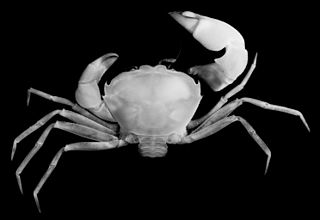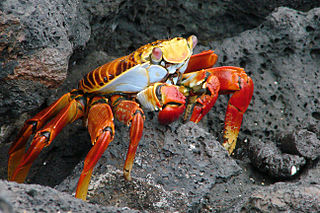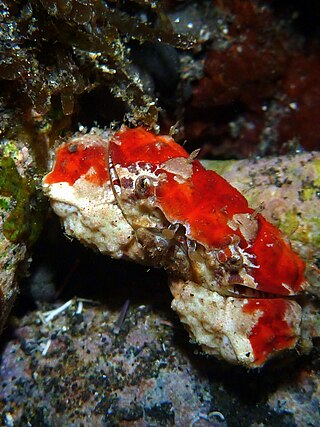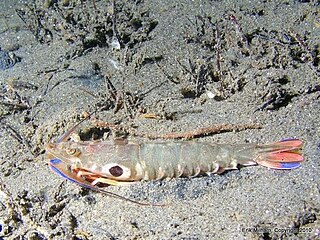
Lissocarcinus is a genus of crabs containing the following nine species :

Majidae is a family of crabs, comprising around 200 marine species inside 52 genera, with a carapace that is longer than it is broad, and which forms a point at the front. The legs can be very long in some species, leading to the name "spider crab". The exoskeleton is covered with bristles to which the crab attaches algae and other items to act as camouflage.

Macrophthalmus is a genus of crabs which are widespread across the Indo-Pacific. It contains the following species : Species in this genus are often referred to as sentinel crabs.

Charybdis is a genus of swimming crabs in the family Portunidae. It is named after the monster Charybdis of Greek mythology.

Calappidae is a family of crabs containing 16 genera, of which 7 are only known as fossils:

Hexapodidae is a family of crabs, the only family in the superfamily Hexapodoidea. It has traditionally been treated as a subfamily of the family Goneplacidae, and was originally described as a subfamily of Pinnotheridae. Its members can be distinguished from all other true crabs by the reduction of the thorax, such that only seven sternites are exposed, and only four pairs of pereiopods are present. Not counting the enlarged pair of claws, this leaves only six walking legs, from which the type genus Hexapus, and therefore the whole family, takes its name. Some anomuran "crabs", such as porcelain crabs and king crabs also have only four visible pairs of legs. With the exception of Stevea williamsi, from Mexico, all the extant members are found either in the Indo-Pacific oceans, or around the coast of Africa.

Pilumnoidea is a superfamily of crabs, whose members were previously included in the Xanthoidea. The three families are unified by the free articulation of all the segments of the male crab's abdomen and by the form of the gonopods. The earliest fossils assigned to this group are of Eocene age.

Percnon is a genus of crabs in the family Percnidae. It has also been included in the family Plagusiidae as subfamily Percninae.

Pseudozioidea is a superfamily of crabs, formerly treated in the Eriphioidea, Carpilioidea, Xanthoidea, Pilumnoidea and Goneplacoidea. A number of fossils from the Eocene onwards are known from the family Pseudoziidae. Eleven genera are recognised in three families:

Etisus is a genus of crabs, containing the following extant species:

Trapeziidae is a family of crabs, commonly known as coral crabs. All the species in the family are found in a close symbiosis with cnidarians. They are found across the Indo-Pacific, and can best be identified to the species level by the colour patterns they display. Members of the family Tetraliidae were previously included in the Trapeziidae, but the similarities between the taxa is the result of convergent evolution.

Grapsus is a genus of lightfoot crabs, comprising the following species:

Mursia is a genus of crabs in the family Calappidae, containing the following species:

Xantho is a genus of crabs in the family Xanthidae, containing five extant species, all restricted to the north-east Atlantic Ocean and Mediterranean Sea, although Xantho granulicarpis is not universally recognised as a separate species from Xantho hydrophilus:

Euxanthus is a genus of crabs in the family Xanthidae containing the following species:

Hypocolpus is a genus of crabs in the family Xanthidae, containing the following species:
Miersiella is a genus of crabs in the family Xanthidae, containing the following species:

Monodaeus is a genus of crabs in the family Xanthidae, containing the following species:

Sicyonia is a genus of prawns, placed in its own family, Sicyoniidae. It differs from other prawns in that the last three pairs of its pleopods are uniramous, rather than biramous as seen in all other prawns.


















